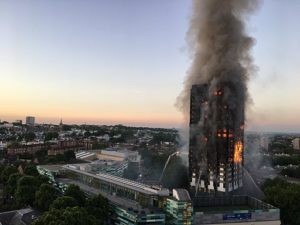Fire prevention
Grenfell cladding 55 times more flammable than other materials
The cladding used on Grenfell Tower was 55 times more flammable than the least flammable panels on the market, according to new research.
 Academics at the University of Central Lancashire have published a new report in the Journal for Hazardous Materials, which claims the combination of polyethylene-filled aluminium composite material (ACM) panels and polyisocyanurate (PIR) insulation used in the building resulted in the highest flammability and smoke toxicity of all the products currently available.
Academics at the University of Central Lancashire have published a new report in the Journal for Hazardous Materials, which claims the combination of polyethylene-filled aluminium composite material (ACM) panels and polyisocyanurate (PIR) insulation used in the building resulted in the highest flammability and smoke toxicity of all the products currently available.
The researchers concluded the ACM panels used on the tower were 55 times more flammable than the least flammable panels tested.
And smoke released when burning polyisocyanurate (PIR) insulation was also found to be 15 times more toxic than current fire-safe insulation products, with just 1kg of burning PIR insulation being sufficient to fill a 50m³ room with an incapacitating and ultimately lethal mix of carbon monoxide and hydrogen cyanide gas.
The findings also highlight the dangers with High-Pressure Laminate (HPL) materials – a popular alternative to the cladding used on Grenfell Tower, and the material which contributed to the death of six people during the 2009 Lakanal House fire.
Heat release rate
Test results revealed that when set alight, it had 25 times greater heat release rate, and released 115 times more heat compared to the least flammable panel products available.
“Our research demonstrates the need for tighter regulations around flammable and toxic building products, especially when used on towers or buildings with vulnerable occupants, as this could put lives at serious risk,” said study author and Professor of Chemistry and Fire Science, Richard Hull.
“The tests that we have carried out provide crucial evidence around the large differences in the fire safety of construction products used on UK buildings, and have clear implications for regulators to ensure the fire safety of occupants living in these buildings.”
In November, ministers laid new regulations in Parliament to ban combustible cladding on new tower blocks.
The ban means combustible materials will not be allowed on the external walls of new buildings over 18-metres containing flats, as well as new hospitals, residential care premises, dormitories in boarding schools and student accommodation over 18-metres tall.
Schools over 18 metres which are built as part of the government’s centrally delivered build programmes will also not use combustible materials, in line with the terms of the ban, in the external wall.
“Even though the Government has recently banned combustible materials from some high-rise buildings in England, regulators need to consider the fire safety of all buildings with combustible façades,” added Professor Hull.
The full study can be accessed here.
Grenfell cladding 55 times more flammable than other materials
Academics at the University of Central Lancashire have published a new report in the Journal for Hazardous Materials
Jamie Hailstone
SHP - Health and Safety News, Legislation, PPE, CPD and Resources Related Topics
New cladding fire risk identified and could be “tip of iceberg”
Who pays for fire safety remedies in residential blocks? Examining the cases so far
Leaseholders obtain first remediation order under Building Safety Act for defective cladding

 Academics at the University of Central Lancashire have
Academics at the University of Central Lancashire have